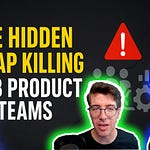The PM life is like a roller coaster, and you know when things will get bumpy.
You get an email from the CEO with the subject: “Quick idea”
You get that Slack message from the Operations Director with another promising idea.
And of course, the Marketing Manager would not forget to send you the seven must-dos because our competitors are nailing us.
What do you do?
You know what to do, but time isn’t on your side.
Let’s imagine a pretty real situation.
Stick with me, and I will show you something you truly wish you had.
Your sales director walks into your office with "just a quick idea" that needs to be live next quarter. Marketing wants three new features to support their upcoming campaign. Support is escalating customer complaints that "should be easy fixes." Your CEO just returned from a conference with a game-changing insight that absolutely must be prioritized.
Meanwhile, you know none of these requests come with user research, market validation, or even basic problem definition. You're being asked to execute on assumptions, build solutions to undefined problems, and hit deadlines based on wishful thinking rather than evidence.
But here's the trap: When you push back and ask for time to do proper discovery, you become the bottleneck. The person slowing things down. The one who "overthinks everything" instead of just shipping features.
You're caught between doing your job right and keeping stakeholders happy. Between building what users actually need and delivering what the loudest voice in the room demands. Between being a strategic product leader and becoming a glorified feature factory manager.
The pressure is real. The timelines are aggressive. And the tools you're using weren't designed for this reality.
The question is, how do you deal with that?
The easiest thing to do is to bow to the pressure and do what the boss wants. It’s “safe,” but is that the right thing to do?
The best approach is to slow down and identify which opportunities will drive the most value. However, that takes time, and structuring discovery is no easy task. Unless you have a tool that does that for you…
Now, I’m going to get you to learn more about VelocitiPM. Is it an ad about the tool? No. It’s a tool, I started getting excited about it, and I believe it can help you as a PM.
I invited the founder to share why he started this and to demonstrate to you how to use it. Let’s get into it.
The PM Who Lived This Problem at Amazon Scale
In this episode of Untrapping Product Teams, I sit down with Anthony Argenziano, founder of VelocitiPM and former product leader at Amazon, eBay, and Intel. Anthony didn't just experience these pressures - he lived them at companies where the stakes couldn't be higher and the pace never slowed down.
His solution isn't about replacing PM judgment or eliminating the need for critical thinking. It's about giving PMs the foundation they need to have informed conversations with stakeholders, rather than flying blind.
It’s a 35-minute episode. Watch it to gain insights, but seriously, try out the tool and check how that helps you. It’s a freemium model, so no commitment for you apart from checking it out. Even if you don’t like the tool, I’m convinced you will want the approach. It’s solid.
10 Hard-Earned Insights from the Trenches
1. The Tool Chaos Is Real and Expensive "Every product person that I spoke to uses five to 10 or more different products, just to manage product discovery, your product strategy, just kind of the PDLC in general."
2. Discovery Time Scarcity Isn't Optional Anymore "Every product manager knows they need to do product discovery, but they just don't have time because they're focusing on so many things."
3. AI Should Amplify Your Expertise, Not Replace It "We do not want to replace product managers. We wanna supercharge them. We wanna make them better at their job, more efficient."
4. Starting With Something Beats Starting With Nothing "This gives you a great starting point because it is easier to kind of refine and take something in and kind of run with it rather than start from blank slate."
5. The Future Favors Small, Empowered Teams "It's either gonna be the product trio that leads all of product development...I think it's gonna be one to three."
6. Requirements Documents Are Waterfall in Disguise "I don't want to hear anything that ends in an RD, right? Because it's the antithesis of Agile and modern product management."
7. PMs Must Stay Product Builders, Not Tool Builders "Accountants aren't building QuickBooks...Salespeople aren't building their own CRMs...build products. Don't worry about the tools."
8. Product Fundamentals Trump Technology Trends "Focus on building the right product, solving the right problems, focusing on personas and jobs to be done...just focus on that."
9. Great Products Win Regardless of Hype Cycles "If you're building great products, if you're building things that your customers love because you're solving real problems for them, you're going to be successful."
10. PMs Are Natural Orchestrators in Complex Systems "The product manager will be kind of the conductor of this product development orchestra...you can't take a human out of it."
What This Conversation Actually Reveals
This conversation is no fluff.
It’s not about AI loading you with stuff, and you trying to get the signs through the noise. This conversation reveals that it’s possible to use AI to amplify PMs ’s potential when you focus on one area.
Anthony focuses on the core part, discovery. That’s messy and unstructured. He used his method, combined with AI agents, to streamline discovery, and I appreciate that.
Anthony demonstrates how his platform works in practice - generating personas, problem maps, and user stories from basic prompts. But the real insight isn't about the tool itself. It's about how PMs can maintain strategic thinking while handling tactical pressures.
The demo showcases what's possible when you have a foundation to build upon, rather than starting every discovery conversation from scratch. When stakeholders present their next "urgent" request, you can quickly model out the problem space, identify assumptions, and have an informed discussion about trade-offs.
This isn't about surrendering your critical thinking to AI. It's about using technology to create the space for better thinking.
The Real Question Isn't Whether AI Will Change PM Work
The question is whether you'll use these changes to become a more strategic product leader or remain trapped in reactive execution mode.
Anthony's framework offers one path forward, but the core principle applies regardless of tools: PMs who can quickly move from stakeholder requests to structured problem analysis will outperform those who can't.
The stakeholder pressure isn't going away. The competing priorities aren't getting simpler. But your ability to respond with insight instead of guesswork can dramatically improve.
Ready to see how strategic PMs are handling the reality of modern product pressure?
Listen to this episode to understand how discovery can happen at the speed of business demands, why the product trio model is gaining traction at major companies, and what specific approaches you can use to maintain strategic thinking under tactical pressure.
P.S. - This isn't about finding the perfect tool. It's about reclaiming your role as a strategic product leader instead of a glorified backlog manager.









